While the effective altruism movement has changed a lot over time, one of the parts that makes me most disappointed is the steady creep of donation matching. It's not that donation matching is objectively very important, but the early EA movement's principled rejection of a very effective fundraising strategy made it clear that we were committed to helping people understand the real impact of their donations. Over time, as people have specialized into different areas of EA, with community-building and epistemics being different people from fundraising, we've become less robust against the real-world incentives of "donation matching works".
Personally, I would love to see a community-wide norm against EA organizations setting up donation matches. Yes, they bring in money, but at the cost of misleading donors about their impact and unwinding a lot of what we, as a community, are trying to build. [1] To the extent that we do have them, however, I think it's important that donors understand how the matching works. And not just in the sense of having the information available on a page somewhere: if most people going through your regular flow are not going to understand roughly what the effect of their choices are, you're misleading people.
Here's an example of how I don't think it should be done:
I come to you with an offer. I have a pot with $30 in it, which will go to my favorite charity unless we agree otherwise. If you're willing to donate $75 to your favorite charity and $75 to mine, then I'm willing to split my $30 pot between the two charities.
How should you think about this offer? As presented, your options are:
Do nothing, and $30 goes from the pot to my favorite charity.
-
Take my offer, and:
- $75 goes from your bank account to your favorite charity
- $75 goes from your bank account to my favorite charity
- $15 leaves the pot for your favorite charity
- $15 leaves the pot for my favorite charity
While this looks nice and symmetrical, satisfying some heuristics for fairness, I think it's clearer to (a) factor out the portion that happens regardless and (b) look at the net flows of money. Then if you take the offer:
- $150 leaves your bank account
- $90 goes to your favorite charity
- $60 goes to my favorite charity
If I presented this offer and encouraged you to take it because of my "match", that would be misleading. While at a technical level I may be transferring some of my pot to your favorite charity, it's only happening after I'm assured that a larger amount will go to mine: you're not actually influencing how I spend my pot in any real sense.
Which is why I'm quite disappointed that Charity Entrepreneurship decided to host a project that, after considering these arguments, decided to build FarmKind:
This is an animal-specific giving platform, largely inspired by GivingMultiplier. [2] It's not exactly the same offer, in part because it has a more complex function for determining the size of the match, [3] but it continues to encourage people to give by presenting the illusion that the donor is influencing the matcher to help fund the donor's favorite charity.
While setting up complex systems can cause people to donate more than they would otherwise, we should not be optimizing for short-term donations at the expense of donor agency.
Before starting this post I left most of these points as comments on the EA Forum announcement. I also shared a draft of this post with FarmKind and GivingMultiplier for review late Wednesday morning:
I've drafted a blog post that is critical of your work, and I wanted to share it with you before publishing it so that you're not surprised by it: Farmkind's Illusory Offer. I'm planning to publish this on Friday (August 7th [JK: this should have said 9th!]) morning, but if you'd like more time to prepare a response let me know and I can delay until Wednesday (August 14th).While GivingMultiplier responsed with a few small requested edits, FarmKind didn't respond. At the time I thought this was because they had decided to stop engaging with me but actually it was because the email ended up in their spam folder. After publishing FarmKind let me know about this and pointed out a few places where I had misunderstood them. I appreciate the corrections and have edited the post.
[1] I think participating in existing donation match systems is
generally fine, and often a good idea. I've used employer donation
matching and donated via Facebook's Giving Tuesday match, and at a
previous employer fundraised for GiveWell's top charities through
their matching system. In the latter case, in my fundraising I
explicitly said that the match was illusory, that I and the other
sponsors would be donating regardless of what others did, and that
people should read this as an invitation to join us in supporting an
important effort.
[2] In 2021 I raised similar issues with GivingMultiplier, prompting them to add a transparency page. I appreciate GivingMultiplier's public explanation, and that FarmKind is also pretty public about how their system works.
[3] GivingMultiplier's algorithm for determining the bonus amount was "50% of the amount donated to effective charity". Here it's usually higher and occasionally lower (sheet):
Comment via: facebook, lesswrong, the EA Forum, mastodon

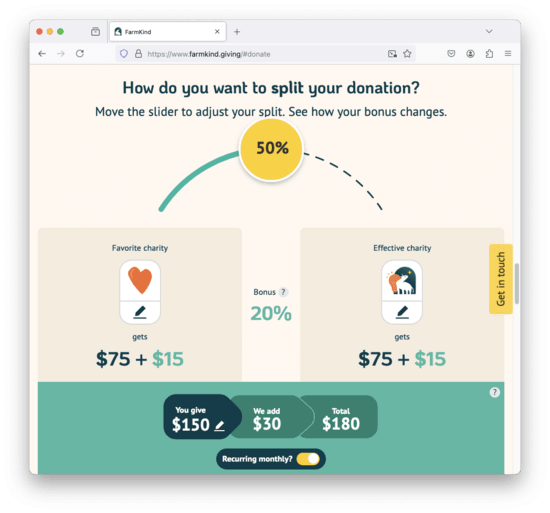
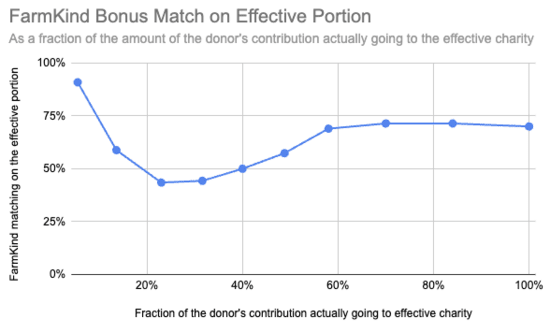
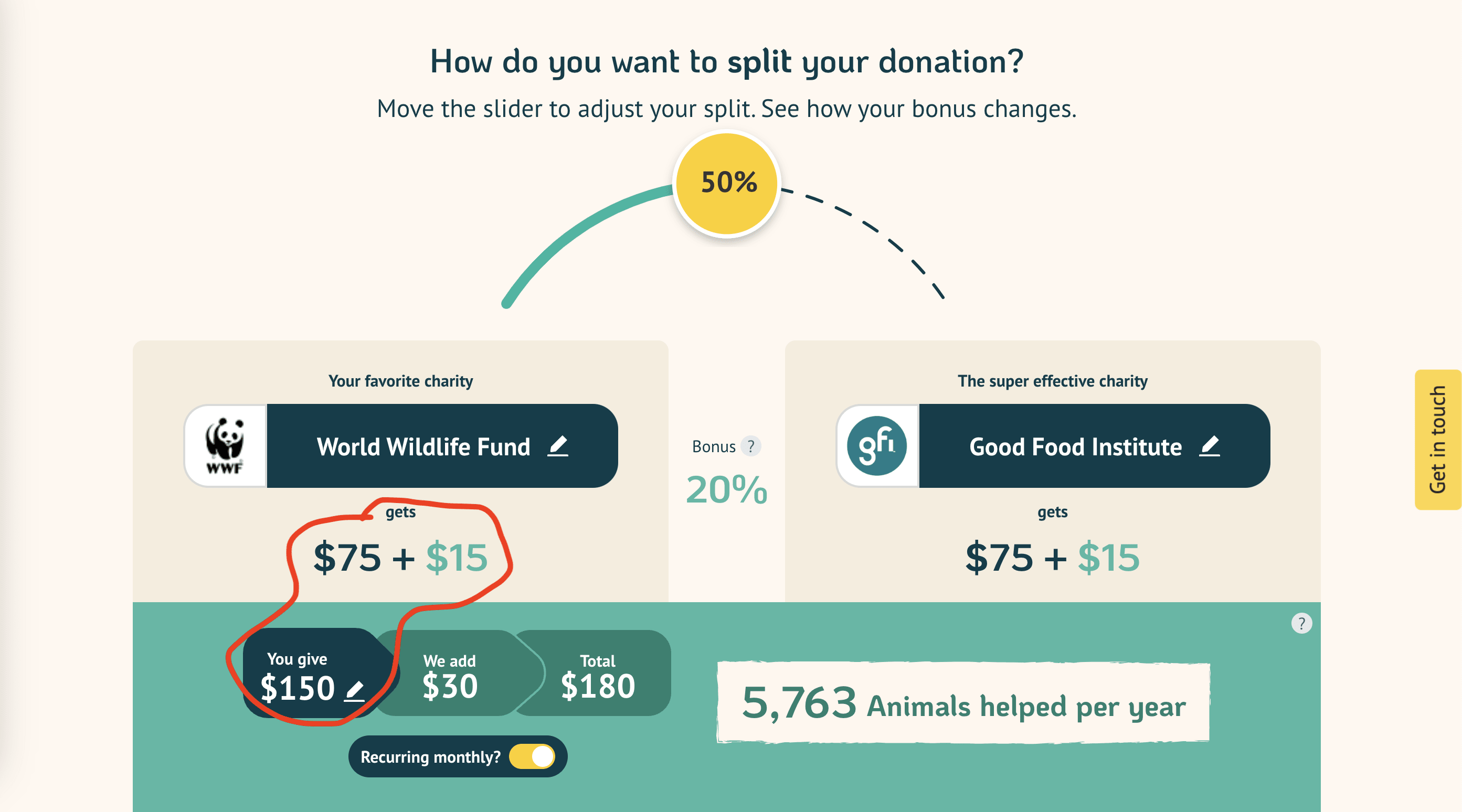
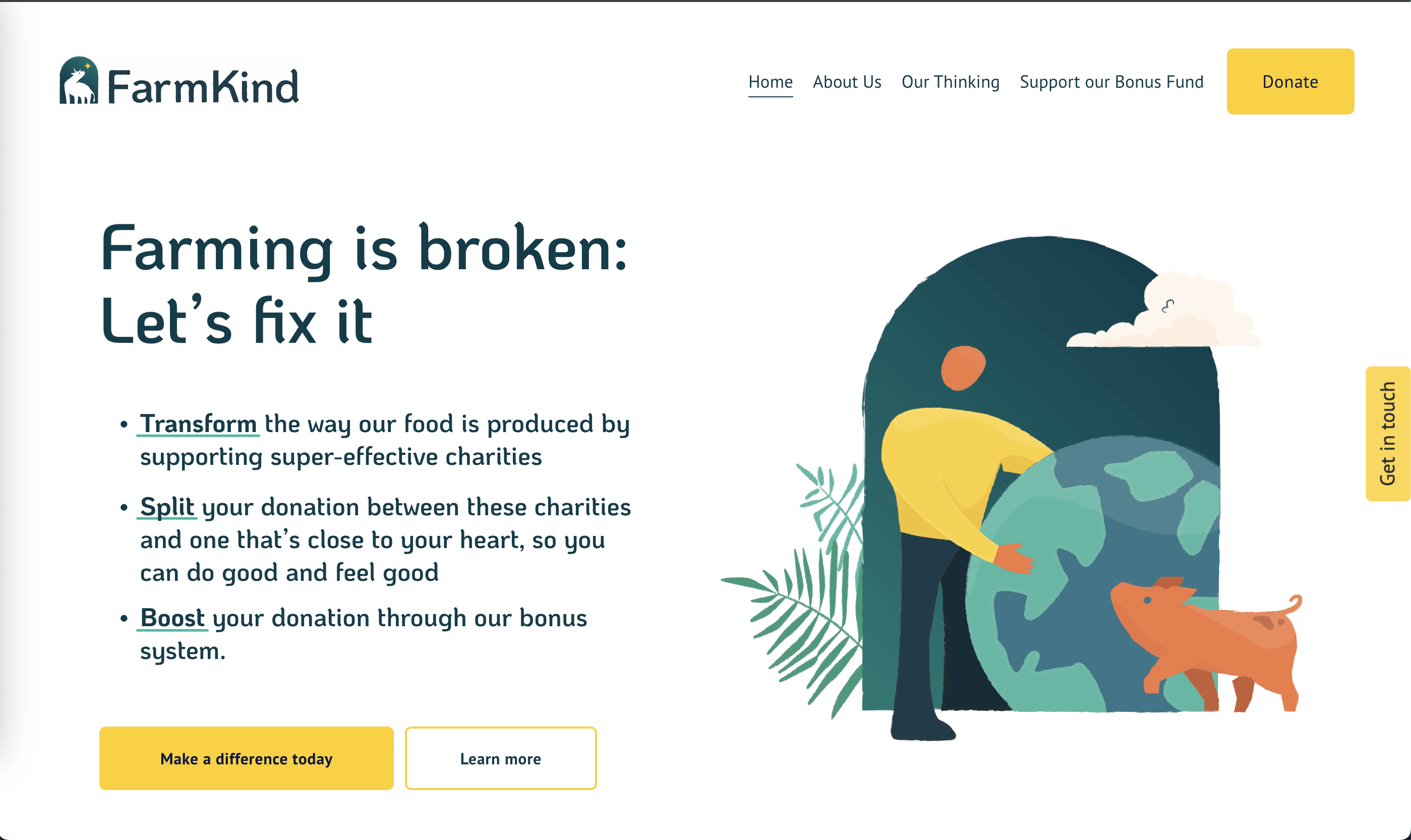
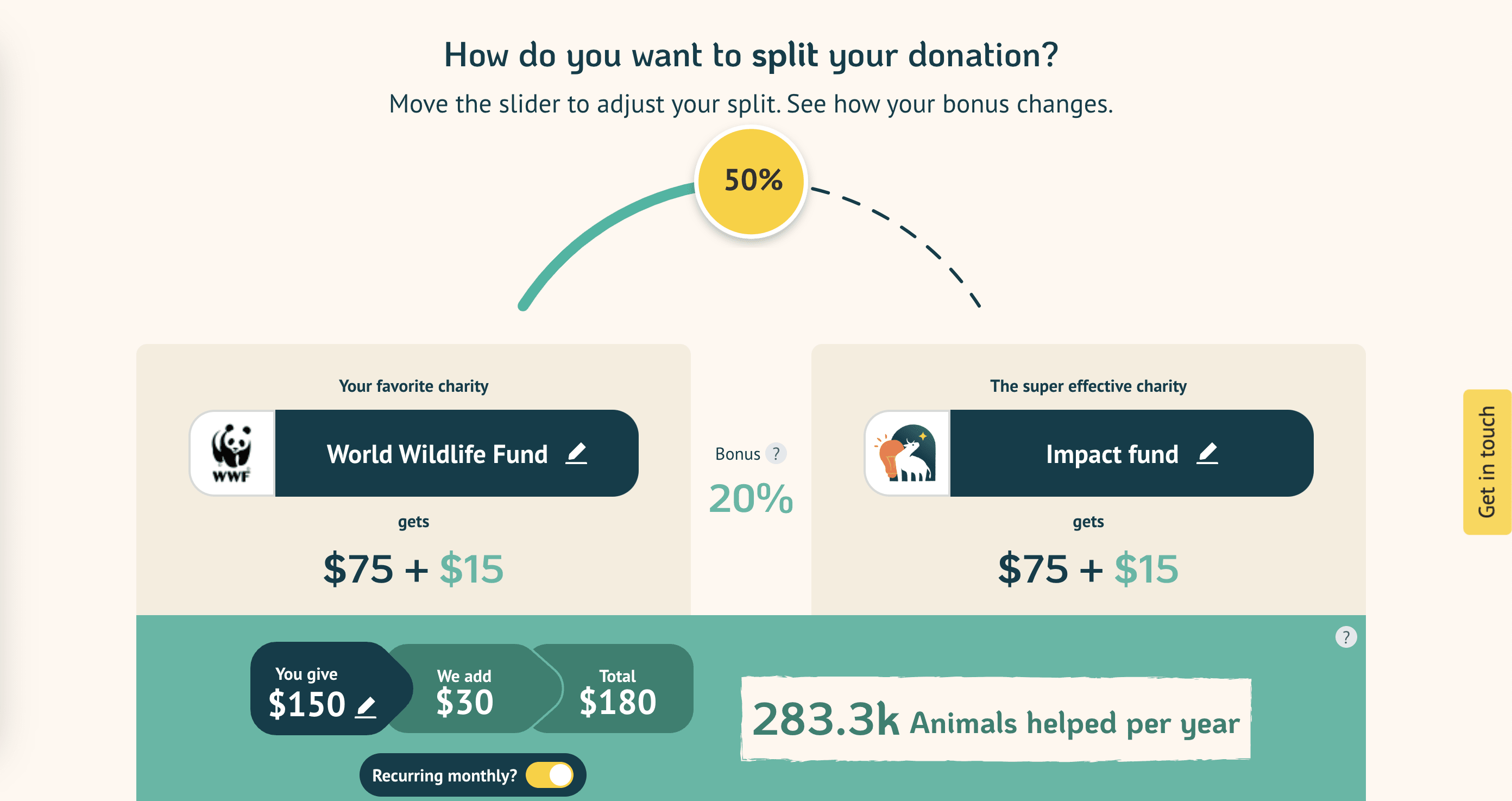
My reflections on 5 criticisms of FarmKind’s bonus system:
Hello!
After receiving impassioned criticisms on our announcement post last week, I decided to use a plane trip (I’ve been on leave) to reflect on them with a scout mindset to make sure Thom and I aren’t missing anything important that would mean we should change our approach. I’m glad I did, because on my way back from leave I noticed this new post. I thought it would help to share my reflections.
To set expectations: We won’t be able to continue engaging in the discussion on this here. This is not because we consider the “case closed”, but because we are a team of 2 running a brand new organization so we need to prioritise how we use our time. It’s important (and a good use of time) for us to make sure we consider criticisms and that we are confident we are doing the right thing.[1] But there is a limit to how much time we can dedicate to this particular discussion. Please enjoy the ongoing discussion, and apologies that we can’t prioritise further engagement with it :)
Before I get to my reflections, I want to point out an unhelpful equivocation I’ve seen in the discourse: Some of the comments speak of donation matching as if it’s one very specific thing, and they claim or imply that we are doing that one thing. In reality, “donation matching” can refer to a wide range of arrangements that can work in all sorts of ways.
The most common form of donation matching that I’ve seen involves a large individual or institutional donor promising to match all donations to a specific charity 1:1 until a certain date. This can be fully counterfactual (if the large donor chooses to participate in the match where they wouldn’t otherwise have given to that charity or any other) or it can be not counterfactual at all (if they would have given that amount to that charity no matter what), or somewhere in between. What we’re doing is different to this, as we explain here and below, which is why we don’t call it donation matching, as we aren’t wanting people to import expectations about how it works from previous experiences they may have had with common forms of donation matching.
It’s fair to have qualms with how some forms of donation matching work (or even all forms of it, as some commenters do). But most of the reasons given for concern about donation matching apply to some and not all forms of it. We would be able to make better sense of this collectively by being precise about what forms of donation matching we do and don’t have problems with and for what reasons.
Okay, on to my reflections on 5 criticisms of FarmKind’s bonus system:
Criticism 1: It’s not possible to donate $X in total and have >$X go to your Favorite Charity, which means we’re not offering a ‘meaningful match’ / we’re not delivering what we promise
We received this criticism: “The fact that you can't donate $X and get more than $X going to your favourite charity means I don't really feel like my donation is being meaningfully matched”.
We never promise or imply that it would be possible to donate $X in total and have >$X go to your Favorite Charity (after splitting and receiving a bonus). We make it very clear that it won’t:
Our comms make it very clear that FarmKind’s purpose is to help users donate to fix factory farming through our Super-effective Charities, with the ability to support your Favorite Charity at the same time and to get a bonus included as perks. It’s hard to see how anyone could read our comms and see things the way the critics are worried they will, and so it’s hard to see how anyone could be misled:
Criticism 2: Our comms suggest that your Favorite Charity receives money from the Bonus Fund, but that isn’t true
We received this criticism: "The 'bonus' is presented to users as if it (a) will go in part to their favorite charity and (b) is money that would not otherwise be going to help animals, but neither of these are true"[2]
We think this is incorrect, because it quite literally IS true that the Favorite Charity receives money from the Bonus Fund. This is how the money flows: Every.org splits the regular donors donation between their chosen Favorite and Super-Effective charity and then Every.org disburses money to each from the Bonus Fund in the exact way that’s summarised during the donation process:
Critics have pointed out that the effect of these cash flows is the same as a different set of cash flows where more of the donor’s money was given to their Favorite Charity than indicated (e.g. $90 of the $150 in the donation went to the Favorite Charity), and all of the bonus went to the Super-Effective Charity ($30 in this case). Those critics claim that this is a simpler set of cash flows, and a simpler/clearer way to understand what has happened. We disagree that it’s simpler or clearer, and even if it were, it wouldn’t be what actually happened, and it wouldn’t make our description misleading.
Criticism 3: Our comms are misleading regarding whether the bonuses we add to donations are counterfactual (criticism fleshed out below)
This is an interesting and nuanced one. The criticism goes something like:
There are valid aspects of this criticism, which I nonetheless disagree with, and there are invalid aspects. Let’s start with what the criticism gets right and wrong about the reality of the counterfactuality of the bonus system:
Counterfactuality of the bonus system
Regular donations do, in expectation, cause more counterfactual donations to occur. Let’s talk through it, considering counterfactuals in both the narrower/direct and the broader/indirect sense:
1. The narrower/direct sense — i.e. Thinking just about the money that’s already in the bonus fund when a regular donation is made:
2. The broader/indirect sense — Regular donations on our platform, which receive a bonus, use up the supply of money that’s in the pool. The more regular donations that occur (i.e. the more demand there is to redeem our bonuses), the more that folks who like how our bonus system is motivation donations will want to keep the system going, by donating to the Bonus Fund. In particular, if the Bonus Fund is running low, we will communicate this to people who like our bonus system, imploring them to donate to keep the system going. As such, each regular donation increases, in expectation, the amount of money contributed to the Bonus Fund.
This is like the how buying one of chickens at the grocery store (which the grocer has already bought and so pre-committed to selling or throwing away) increases the expected amount of chicken they will buy next time. If you think that lower demand for animal products can decrease the amount of animal products produced, you should understand how increased demand for bonus funding can increase the amount of money given to the Bonus Fund.
But what would have happened to the money donated to the Bonus Fund were it not for past demand?
Do we communicate about it in a dishonest way?
Certainly not. Our communications are accurate, both in the ‘large print’ and the ‘fine print’.
Do we communicate about it in a misleading way?
It is possible to be misleading without being dishonest, however. This can be done by presenting information in a way that leads someone to draw incorrect conclusions, even though the facts themselves are technically true. Typical ways to do this is by omitting certain information, or framing the facts in a particular way.[3]
To cut right to the chase: Will some people who don’t read our communications carefully think that they’re having direct counterfactual impact on total donations, when they aren’t [as per (1)(a)]? Probably yes, there is always a risk that some people will get the wrong idea. However, we don’t believe that this constitutes misleading communication. Let me explain why:
Criticism 4: By encouraging both regular and bonus donors to participate in the bonus system to amplify their impact, we’re causing a double-counting of impact which is suboptimal for collective resource allocation
This is also an interesting one, which we’re grateful was raised, and we will incorporate this into future comms.
Such a double count is likely, and is one of the challenges with counting impact using standard counterfactual reasoning (see discussion here and here). These kinds of double-countings are actually really common. For example, whenever two advocacy groups both play a necessary role in achieving a policy change, they will generally both conclude that the counterfactual impact of their work is the full impact of the policy change. This double count of impact can lead to an inaccurate view of the cost-effectiveness of each group, leading to suboptimal grantmaking decisions.
What are we to do about this? Surely the answer isn’t to not encourage both groups to participate in our bonus system — after all, the participation of each group counterfactually causes higher impact. Each group benefits (in terms of increased impact. We don’t think the answer is to introduce Shapley Values or some other more complicated means of impact attribution, which would compromise our ability to communicate the value to each group. Rather, we should probably talk about the increased impact each group will have in general terms, without using specific numbers unless someone asks for them and/or we heavily caveat them. Having received this criticism, we would not use specific numbers the way we did here again.
It’s worth mentioning that, of course, resource allocation is extremely far from perfectly efficient, so the real cost of these kinds of double counts is probably very low. It’s also worth reiterating that this problem applies to nearly every intervention in EA — it is not a particular problem of donation matching.
Criticism 5: FarmKind uses a form of donation matching, and even if fully understood and consented to by all parties, matching does not belong in EA because.. [various reasons]
It is reasonable to disagree about what is and is not ‘EA’. For example, we have similar disagreements with many EAs’ cause area prioritisation, epistemics, use of funding, communications styles. We also see many projects that don’t meet what we see as minimum standards in terms of the existence of feedback loops, theories of change, or measurement and evaluation.
We personally wouldn’t choose to claim there is no place for these people or projects in EA. We think that there is value in a more pluralistic and diverse EA community that takes many different approaches, all motivated by the honest desire to do the most good we can.
I’m sure it’s clear from our choice to launch this platform that we think this is a good thing to be doing, and that it’s our attempt at doing altruism effectively. If some folks who disagree decide that FarmKind does not belong in effective altruism, there is likely nothing we can say that will change their mind. That’s ok.
I don’t have more to say about this criticism except to reiterate that I respect its intention, I disagree and I thank people for sharing it. We considered Jeff’s critique post of Giving Multiplier prior to deciding to launch FarmKind and we were grateful to come across this perspective before rather than after making the decision — it influenced decisions we made for the better.
Thanks for reading, and happy foruming!
To that end, if any new points are made in response that we haven’t considered, we will consider them and may change our mind, but we may not neccessarily report back about this.
Criticism 2 is about part (a) of this statement. We discuss part (b) under Criticism 3
For example, stating "Our product has been used by over 1 million people!", when 99% of people used it once, were dissatisfied and never used it again. The statement is true (and in that sense, not dishonest), but it omits context so that it might lead someone to believe that 1 million people are active, happy users, which isn't the case.
3rd example: The donation platform Ribon using the half-sentence “Ensure free-range living for farm animals” to describe the impact of donating to a specific charity, even though no given donation can possibly guarantee this outcome is achieved (I think this is acceptable, and I’d hope that further comms were available for those who are interested enough to read more to understand how their donations might have an impact).
4th example: Saying “I like ice cream”, even if you think that the self is an illusion (an illusion which your statement reinforces), such that you’re giving the false impression that you think the self is a real thing (I include this example because I imagine that even our most steadfast critics would agree this is honest communication. The kind of person who caveats their use of the word ‘I’ is probably failing to communicate)
Disclaimer: I am mostly skimming as there's a lot to read and haven't gotten through it all. But I do believe part of the idea with FarmKind is that the donors are already sympathetic to animal charities, and agree with the premise of effective animal charities, but also just want to get some warm fuzzies in as well. As opposed to most of their money going to something they do not agree with or have any care for.